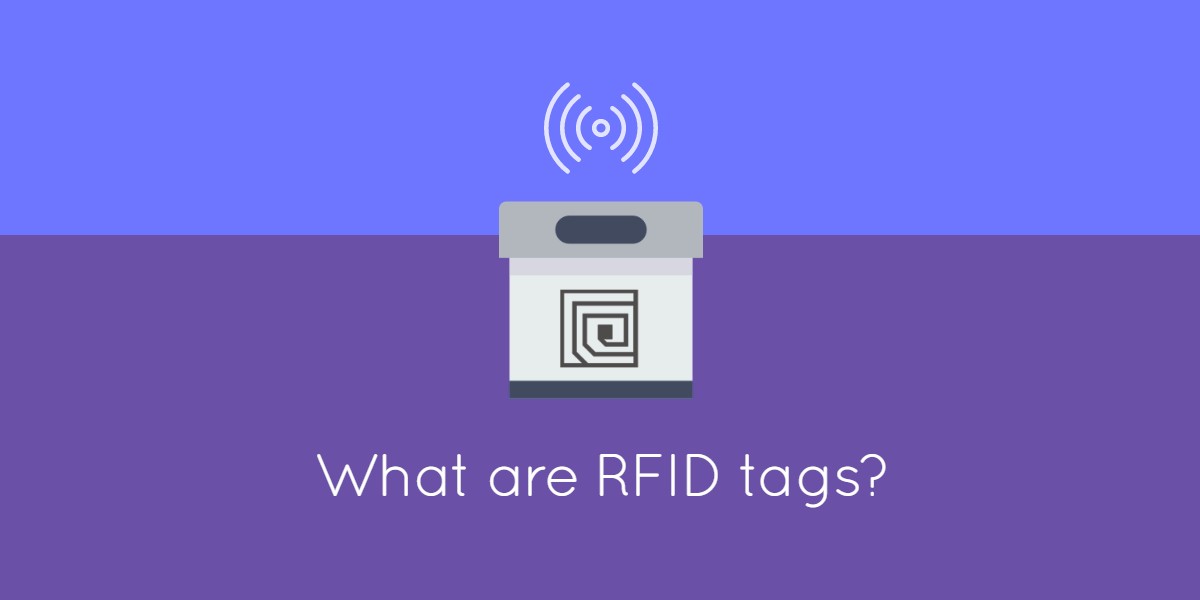RFID tagging is an advanced method of equipment tracking. It is becoming exceedingly popular with many industries now opting for it. The primary advantage of using RFID tags is that they allow mass data collection as opposed to barcodes that enable data collection one item at a time.
RFID readers also have the ability to detect items from a distance without having to be in the direct line of sight of an RFID tag. This means RFID tagging can easily locate hidden items and establish tighter control over them, making it an ideal choice for high-ticket assets.
How does the RFID system work?
RFID technology consists of a tag or a transponder, an antenna and a computer where you store all the information. The tags are detectable from a distance of several feet and can scan multiple items together.
An RFID system can be broken down into two main components. The first component is the RFID tag which transmits data as radio signals. The second is the RFID reader itself, which receives, converts and then stores these radio signals as usable information.
For a better understanding, let’s divide the RFID process into four simple steps:

- An RFID tag is attached to an asset. This tag consists of a circuit that stores relevant data and an antenna that transmits this data.
- The antenna in the tag communicates with the reader. It transmits the stored data in the form of radio waves.
- The RFID reader receives and converts the radio waves into usable information.
- This usable information then passes through a communications interface to a host computer system, where it is stored to be used later on.
Types of RFID tags
Now that we’ve discussed how important RFID tagging is, it’s time to dive into different types of RFID tags and see which ones are a better fit for your business. There are two basic types of RFID tags: active and passive.
1. Active RFID Tags
Companies prefer active RFID tags when they need to track real-time locations of various items. Active RFID tags operate on their own power source, usually a battery. This is how the ‘real-time’ aspect is made possible. Therefore, these tags are able to broadcast signals on a continuous basis.
Active tags also offer a more extensive range over which they can scan goods. Therefore, you might want to opt for active RFID tags if you have high-value goods to keep track of at all times.
Active tags are typically larger in size than passive tags. They are also robust in design so you don’t have to worry about them tearing off.
These tags do come with a downside of course. As their readable range increases, so does their cost. They come with a hefty price tag in comparison to passive RFID tags. This is why they aren’t feasible for low-cost items.
Moreover, in order to use active tags, companies might need to train their employees to use complex software programs associated with them.
2. Passive RFID Tags
Most companies use passive RFID tags more commonly due to the fact that they are less expensive to implement. They are an economical choice for many industries.
Moreover, they are also much smaller in comparison to active RFID tags, which is a plus point for companies that contend with small-scale items.
However, the downside is that passive RFID systems don’t have a power source of their own. Therefore, they need time to charge by drawing power from the RFID reader before any data transmission can take place. Another drawback is that passive tags come with less memory storage capacity in comparison to active tags.

If you’re looking to track high-value goods, then active tags are your best bet. However, if huge costs are a concern for you, then you should go for passive RFID tags.
Uses and applications of RFID Tags
RFID systems have braved their way to countless industrial applications, owing to the ease they offer companies in tracking large amounts of assets.
The uses of RFID tags range across several functions, from inventory or asset tracking to supply chain management. Let’s take a look at some common applications of RFID tagging in today’s business world.
1. Logistics and supply chain visibility
The RFID system is used in the supply chain to automate processes. This ultimately leads to a decrease in manual errors and an increase in efficiency and quality.
In addition to this, RFID also allows access to real-time data on individual assets. This can help provide detailed insights into any problems that may arise in the entire supply chain process. Companies can then translate these insights into actionable measures for a more seamless supply chain.
2. Inventory tracking
The retail sector focuses on tracking assets at an individual item level. Keeping this aspect in mind, the retail industry presents a large market for RFID labels. This is because these tags present a cost-effective way of tracking inventory.
For example, bookstore giants Barnes & Noble use RFID tags to identify when a book is removed from its place and returned to the publishing house.
Another aspect of inventory tracking is shipping management, which is also something RFID tags are often used for. The tags help in identifying the location and movement of inventory and even the contents of the shipment. Walmart is famous for its use of RFID technology in tracking shipments of merchandise.
3. Employee tracking
RFID tags can also track employee movements and help provide them access to secure locations. An example of tracking employees can be an organization’s basic attendance system.

Usually, companies give each employee an ID badge. From educational institutes to the corporate world, almost all the employees need to scan their ID badge at the entrance of the office to mark their attendance for the day. The RFID tag within the ID badge makes it possible!
Time to implement an RFID solution
An RFID system comes with a whole set of advantages for companies, no matter the industry. The technology may be complex in comparison to barcodes or QR codes, but the advantages are worth it.
We recommend placing the readers at critical locations like departmental entrances and warehouses. We also recommend protecting the tags with a layer of plastic to ensure that they aren’t torn away. This is a popular practice in organizations where employee ID badges have a plastic layer for protection purposes and longevity of the tag.
RFID tags allow organizations to track asset locations at all times, thereby improving visibility with real-time data. They also enable you to drastically speed up equipment processing with the ability of an RFID system for mass data collection.
If you wish to increase the efficiency of your daily business processes, now is the time to implement a dedicated RFID system.
Read more: 7 Things To Track with RFID Hospital Asset Tracking Solution
About EZOfficeInventory
EZOfficeInventory is RFID asset tracking software that enables companies to track, maintain and report on equipment from anywhere, at any time.







